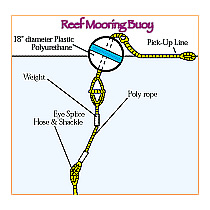Key West Reef Mooring Buoy Program
Reef Relief installed a total of 116 reef mooring buoys at 7 Key West-area coral reefs and maintained them for a period of 10 years. It was the largest private mooring field in the world and was available to the public at no cost. The buoys are now part of the Florida Keys National Marine Sanctuary reef mooring buoy program.
Beginning in 1986, Reef Relief installed and maintained 116 mooring buoys at seven Key West-area coral reef that are still available for use at no cost to the public. The greatest advantage to reef mooring buoys is that they greatly reduce anchor damage to the living coral reef.
 These buoys were officially transferred to the Florida Keys National Marine Sanctuary in October, 1997. The reef mooring buoys provide a safe and easy method of eliminating anchor damage by the world’s largest fleet of charter boats. Boaters are encouraged to hook up to the buoys because they eliminate the need to drop anchor on the fragile living coral reef.
These buoys were officially transferred to the Florida Keys National Marine Sanctuary in October, 1997. The reef mooring buoys provide a safe and easy method of eliminating anchor damage by the world’s largest fleet of charter boats. Boaters are encouraged to hook up to the buoys because they eliminate the need to drop anchor on the fragile living coral reef.
HOW TO USE MOORING BUOYS
- Slowly approach the buoy from down wind and/or down current.
- Smaller boats are encouraged to tie off to one another, thereby allowing larger vessels access to buoys. Remember, the larger the vessel, the more potential damage to the coral (if an anchor is used).
- All boats should put out extra scope by adding an extra line to create a horizontal pull on the eyebolt. Otherwise, the eyebolt will be pulled out. A good rule to remember is: if the buoy is pulled underwater, you must let out extra scope.
- Inspect the mooring buoy your boat is tied to — you are still responsible for your vessel.
- Sailboats should not leave large sails up as steadying sails when on a buoy; this puts too much strain on the eyebolt.
If you choose not to use a mooring buoy, anchoring is only permitted in the sandy areas. DO NOT ANCHOR ON CORAL! This is Florida State Law and prohibited within Sanctuary Preservation areas of the Florida Keys National Marine Sanctuary.